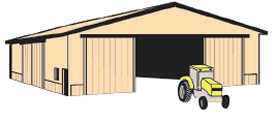

To send a message to an author, click on the author's name at the end of the article.
This Month in Ag Connection | Ag Connection - Other Issues Online
Farm buildings or livestock facilities not needed by the landowner may be of value to farmers. Developing a farm lease may be a beneficial solution for both parties. A lease benefits a landowner by receiving a return on an asset that would either not be used at all or under-utilized. The tenant benefits by not having to invest to build expensive fixed assets.

The most difficult part of a rental agreement is fair compensation. There are many ways to determine a rental value. Two popular methods are owner's cost and commercial rates.
Owner's Cost method takes into account the costs incurred by using the building, or variable costs. Variable costs include utilities, repairs, and maintenance. At a minimum, the rent should cover all variable costs. Fixed expenses, those costs occurring regardless if the asset is used, are the majority of the owner's expenses. Those include: depreciation, property taxes, interest, and insurance. Total costs (variable plus fixed) can be calculated and may be helpful to determine a rental rate.
Commercial Rate is another method. Some assets such as grain bins have a comparable commercial rate, in this case local elevators. Typically, on-farm grain bin rental rates are lower than commercial rates. Renting grain bins requires more labor and more risk for the tenant. The tenant must keep the grain in condition. Many times the rented facilities take more work getting the grain into the bin and taking the grain out of the bin. If this method is chosen, typically a percent of the commercial rate is used to calculate rent.
Both methods provide a starting point for negotiating. Typically the rate will not be the lowest price, nor the highest and will be somewhere in the middle.
Rental agreements for buildings and facilities should include how to handle items related to using the facility. The agreement should specify who pays for repairs and how they are accomplished. If the agreement is for livestock facilities then the water issues need to be addressed in the agreement. Livestock facilities agreements may need to state how animal wastes will be handled. Insurance is another item that should be defined in the agreement. Typically each party insures their own property.
These items and much more are discussed in a new publication. The Extension North Central Region (twelve states including Missouri) farm management committee created a new publication called "Rental Agreements for Farm Buildings and Livestock Facilities". The publication includes a sample rental agreement. The publication can be obtained online at http://aglease101.org/DocLib/docs/NCFMEC-04A.pdf or from extension ag business specialists.
Source: Mary Sobba, Ag Business Specialist
This Month in Ag Connection | Ag Connection - Other Issues Online
While soil pH is an excellent indicator of soil acidity, it does not determine lime requirement to neutralize that acidity. Measuring soil pH only measures the active acidity in the soil water. Potential acidity, a function of soil clay and organic matter should also be considered when developing a lime requirement. Four factors have a major impact on successful neutralization of soil acidity by lime: rate of lime applied, lime purity (relative to 100% calcium carbonate - the lime's CCE [calcium carbonate equivalent]), fineness, and amount of incorporation into the soil.
When soil tests are performed, labs make lime recommendations based upon the pH of the soil (the soil's active acidity), and a measure of the soil's structure or buffering capacity. The buffering capacity of a soil is often expressed as the soil's resistance to pH change. Buffering capacity increases as clay and organic matter increase. Sandy soils are weakly buffered, requiring less lime to change the soil pH.
Agricultural liming materials contain both coarse and fine materials. The reaction rate and degree of reactivity of lime increase as the liming material's particle size decreases. Three to four years after application, ag lime particles larger than 10- to 15-mesh will have dissolved little, while the majority of lime particles in the 50- to 60-mesh size will have broken down. The larger particles will have little effect on soil acidity (and pH), while the smaller particles will have rapidly neutralized soil acidity.
Soil test results and recommendations generated by the University of Missouri Soil & Plant Testing Lab report lime recommendations in terms of ENM (effective neutralizing material). The ENM value of a liming agent takes into account both the CCE and fineness of the lime. Data on the purity and fineness of a particular liming material are printed semiannually in the Missouri Agricultural Liming Materials Report, a copy of which is available online at http://aes.missouri.edu/pfcs/aglime or from your regional extension agronomy specialist. These data are also available from individual quarries.
Source: Alix Carpenter, Agronomy Specialist
This Month in Ag Connection | Ag Connection - Other Issues Online
By May cool-season crops should be planted. Crops such as lettuce, spinach, and radishes may be ready for harvest. Broccoli should be ready for harvest in late May and early June along with snow peas, kale, cilantro, and other greens. In June, most cool-season vegetables need to be pulled out and the garden can be replanted with warm-season crops. Broccoli plants can be left in the garden; when temperatures cool off in the fall the plants put on another growth of florets which can be harvested past the first frost.

Tomatoes, peppers, eggplant, melons, squash, and other warm-season crops should be planted after the danger of frost is past (usually mid-May). Consider incorporating companion plants such as basil, dill, borage, marigolds, nasturtium, and geraniums among warm-season crops. Companion plants benefit each other in pollination, nutrient uptake, and pest control.
By late May strawberries are usually ready for harvest in northern Missouri. Strawberries are nutritious and an excellent source of vitamin C. Botrytis Blight, also known as Gray Mold, is a common fungal disease of strawberries. Ripe berries are the most susceptible. Avoid heavy applications of nitrogen in the spring. Mulching around plants and between rows with clean straw will keep berries from contacting the soil. Pick berries as they become ripe, preferably early in the day but after the plants are dry, to avoid spreading the causal fungus.
Disease can be an issue for some plants with wet spring conditions. Monitor all plants regularly for insects and disease. Common springtime diseases include Peach Leaf Curl on peaches and nectarines; anthracnose on shade trees; fireblight on apples, pears and some ornamental pears; tar spot on maples; and cedar-apple rust on crabapples and apple trees. Bagworms can be a problem on many plants, but most troublesome on needled evergreens like spruce, juniper and arborvitae. Remove any bags you find on your trees and shrubs. Control of this pest is best done in late May and early June while the larvae are small. Flea beetles can be a problem on radishes and eggplant.
Lawn grass should be never be mowed to a height less than three inches. A lawn mowed high will be better able to shade out weeds creating a thicker, denser lawn. If weeds have taken over the lawn, consider taking a soil test. A weedy lawn is often an indication of a low soil pH. By correcting the soil and raising the pH level, the soil will become less desirable for weed growth. Consider spraying the weeds before applying recommended soil amendments. There are several products available on the market for home lawn weed control.
Grass is sometimes hard to establish in shady areas. Lower limbs may need to be pruned to allow some light into the area. Ground covers are good choice in areas with dense shade. For more information on caring for home lawns and growing fruits and vegetables, contact the county extension center and ask about horticulture guides.
Source: Jennifer Schutter, Horticulture Specialist
This Month in Ag Connection | Ag Connection - Other Issues Online

Weather events have a large impact on Missouri's farming operations. Given the importance of weather to the success of Missouri's farms, the University of Missouri Extension Commercial Agriculture Program has placed weather stations throughout Missouri.
Data from these stations are reported as menu items on AgEBB (Agricultural Electronic Bulletin Board). The locations are listed by county. In Northeast Missouri, weather stations are located in the following counties: Audrain, Boone, Callaway, Carroll, Knox, Linn, and Monroe.
Archived weather information is reported hourly and daily at each location. The conditions observed are:
The summaries of these weather elements are presented on AgEBB as the following menu items:
In Northeast Missouri, real-time weather information can also be obtained from these stations.
Information on the weather stations can be found at: http://agebb.missouri.edu/weather/stations
Weather information is especially useful for crop farmers, as there is information on degree days, rainfall and soil temperature. It can also useful to livestock farmers, as the records on temperature and humidity can be useful in managing ventilation and cooling systems in confinement livestock buildings.
Horizon Point is another service that is offered by University of Missouri Extension. It is a custom weather analysis system for farmers, which includes site specific information.
Farmers can subscribe to a weed-emergence outlook as part of the MU Horizon Point service. Emails report weeds, insect emergence, soil temperatures, rain runoff risks, weather forecasts and other management information.
To subscribe to Horizon Point, go to http://agebb.missouri.edu/horizonpoint then submit an email address, location of farm by longitude and latitude, and soil type. More than one farm location can be entered. Forecasts are site-specific to each farm location.
Further weather information can be found at: http://agebb.missouri.edu/weather
Source: Kent Shannon, Ag Engineering Specialist
This Month in Ag Connection | Ag Connection - Other Issues Online
The University of Missouri Plant Diagnostic Clinic was established in 1965 to provide answers to plant health questions. The clinic receives samples from various agencies, businesses and private citizens throughout Missouri.
The clinic welcomes sample submissions. In addition to serving the public, individual samples help to determine what plant health issues are occurring around the state. All diagnostic results are maintained in the National Plant Diagnostic Network and National Repository. This system helps track disease occurrence and spread, quarantined or threatening pest locations and noxious weeds.
Patricia Wallace is the new clinic director. When necessary, the clinic can utilize the expertise of University of Missouri State Extension Specialists and faculty in the Division of Plant Sciences who specialize in Agronomy, Entomology, Horticulture or Plant Pathology to ensure accurate and effective diagnosis and reporting.
Please visit the Plant Diagnostic Clinic website at http://plantclinic.missouri.edu for: Information on how to collect and ship a sample, Submission forms (types of samples accepted), Plant Disease Identification, Turfgrass Disease Identification, Insect / Arachnid Identification, Plant / Weed Identification (to include mushrooms), Clinic hours for dropping off a sample, and Fees associated with services
Source: Patrcia Wallace, Plant Diagnostic Clinic Director
Publishing Information
Ag Connection is published monthly for Northeast and Central areas of Missouri producers and is supported by the University of Missouri Extension, the Missouri Agricultural Experiment Station, and the MU College of Agriculture, Food and Natural Resources. Managing Editor: Mary Sobba.